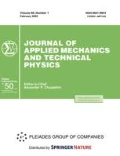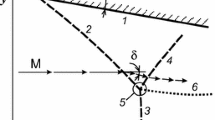Abstract
The problem of optimization of gasdynamic variables behind a system of two steady oblique compression shocks with restrictions imposed on the flow-defection angle is considered. The intervals of input parameters, in which this system turns out to be more effective than one shock, are determined. On the basis of an analysis of the system optimal for the static pressure, the physical meaning of the transition from one type of the reflected discontinuity to another is explained for the problem of interaction of overtaking oblique compression shocks.
Similar content being viewed by others
References
A. V. Omel’chenko and V. N. Uskov, “Optimal impact-wave systems,”Izv. Ross. Akad. Nauk, Mekh. Zhidk. Gaza, No. 6, 118–126 (1995).
G. I. Petrov,High-Velocity Aeromechanics and Space Research [in Russian], Nauka, Moscow (1992).
R. German,Supersonic Inlet Diffusers [in Russian], Fizmatgiz, Moscow (1960).
G. N. Abramovich,Applied Gasdynamics [in Russian], Part 1, Nauka, Moscow (1991).
A. L. Adrianov, A. L. Starykh, and V. N. Uskov,Interference of Steady Dasdynamic Discontinuities [in Russian], Nauka, Novosibirsk (1995).
A. V. Omel’chenko and V. N. Uskov, “Maximal supersonic-flow deflection angles in impact-wave systems,”Izv. Ross. Akad. Nauk, Mekh. Zhidk. Gaza, No. 3, 148–156 (1998).
A. V. Omel’chenko and V. N. Uskov, “Decay of a centered Prandtl-Meyer compression wave in a steady gas flow,”Prikl. Mekh. Tekh. Fiz.,39, No. 3, 59–68 (1998).
G. S. Roslyakov, “Interaction between identically oriented planar shocks,” in:Numerical Methods in Gas Dynamics [in Russian], Izd. Mosk. Univ., Moscow (1965), pp. 28–51.
V. Vust, “On the theory of branched compression shocks,” in:Gas Dynamics [Russian translation], Izd. Inostr. Lit., Moscow (1950), pp. 131–143.
F. Vecken, “Limiting positions of fork-like compression shocks,”Mekhanika, No. 4, 24–34 (1950).
A. V. Omel’chenko and U. V. Uskov, “Optimal impact-wave systems under restrictions on the total flow-deflection angle,”Izv. Ross. Akad. Nauk, Mekh. Zhidk. Gaza, No. 2, 142–150 (1996).
A. V. Omel’chenko and U. V. Uskov, “An optimal shock-expansion system in a steady gas flow,”Prikl. Mekh. Tekh. Fiz.,38, No. 2, 40–47 (1997).
Additional information
Baltic State Technical University, St. Petersburg 198005. Translated from Prikladnaya Mekhanika i Tekhnicheskaya Fizika, Vol. 40, No. 4, pp. 99–108, July–August, 1999.
Rights and permissions
About this article
Cite this article
Omel’chenko, A.V., Uskov, V.N. Optimum overtaking compression shocks with restrictions imposed on the total flow-deflection angle. J Appl Mech Tech Phys 40, 638–646 (1999). https://doi.org/10.1007/BF02468438
Received:
Issue Date:
DOI: https://doi.org/10.1007/BF02468438



